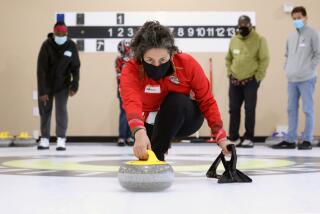Sochi Olympics 2014: The Scottish isle where curling stones are born
- Share via
Ailsa Craig is a wee North Atlantic isle off Scotland that looks like a big curling stone. If you don’t know what those are, you probably haven’t been watching the sport of curling at the Winter Olympics in Sochi, Russia.
It’s played with brooms and a shiny stone that’s made exclusively from rare granite mined on Ailsa Craig. (For the uninitiated, here’s how L.A. Times columnist Bill Plaschke describes the game: “It’s the Olympics’ most relatable and honest of endeavors, an odd mixture of shuffleboard and chess featuring unassuming athletes seemingly lifted from your next-door neighbor’s porch.”)
Guide Mark McCrindle of Girvan, Scotland, takes visitors to Ailsa Craig on his small boat. He says some come to climb to the top of the volcanic isle while others want to see where curling stones come from.
“It’s the toughest granite in the world, and ideal for curling,” McCrindle says via email. Others come to see vast numbers of seabirds like gannets and puffins.
A company on the mainland called Kays of Scotland manufactures the Olympic stones. It has rights to mine three types of granite — common green, blue hone and red hone — that are used in high-quality curling stones, according to the company’s website.
Recently, the island has been up for sale too. London’s Guardian newspaper calls it the “granite jewel of the Firth of Clyde.” The paper reported in December that it may be taken over by a conservation trust and that the asking price had been reduced to $2.4 million.
Olympic curling preliminary competition continues this week. Women’s finals will be held Feb. 20 and men’s finals Feb. 21.
Mary.Forgione@latimes.com
Follow us on Twitter @latimestravel, like us on Facebook @Los Angeles Times Travel.
More to Read
Sign up for The Wild
We’ll help you find the best places to hike, bike and run, as well as the perfect silent spots for meditation and yoga.
You may occasionally receive promotional content from the Los Angeles Times.








